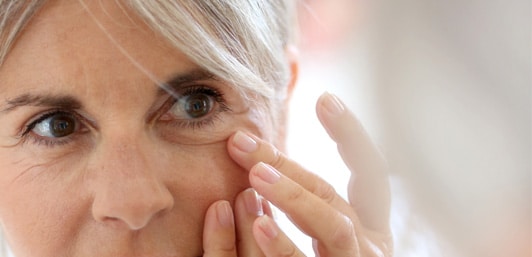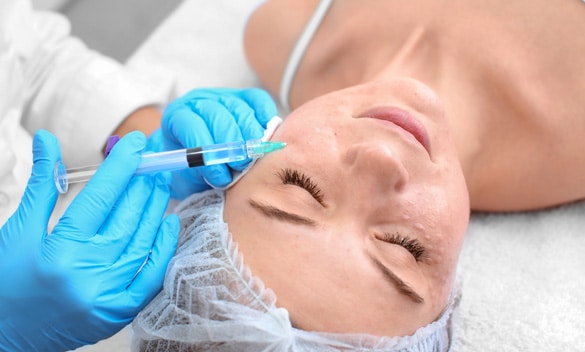Fillers

Dermal fillers are one of the most popular cosmetic treatments available today. Dermal fillers can be used to add volume to the cheeks, smooth out wrinkles, and plump the lips. Unlike surgery, they provide a non-invasive way to achieve a more youthful appearance. Injectable fillers are made from natural or synthetic materials and are used to add volume to the skin. They can benefit people of all ages and skin types. Treatment with dermal fillers is minimally invasive and can provide long-lasting results with minimal side effects.

Best Candidates for Fillers

Moderate to severe wrinkles

Sunken cheeks

Undereye circles
Dermal fillers are a type of cosmetic treatment that can improve your skin’s appearance. They are injected into the skin to help fill in wrinkles and fine lines, plump up thinning lips and add volume to hollow cheeks. Dermal fillers are typically considered to be safe and effective, with minimal side effects. Patients can expect to see results within a few days after their treatment. Before opting for it, it is important to consult a qualified surgeon who can evaluate your specific needs and recommend the best dermal filler. Botox can complement dermal fillers by targeting dynamic wrinkles, such as those on the forehead and frown lines, by temporarily relaxing the muscles that cause these wrinkles.
If a more comprehensive approach is considered, a brow lift or upper eyelid surgery might be recommended to achieve optimal rejuvenation in the upper face area.
Types of Fillers
Dermal fillers are a popular treatment for reducing wrinkles’ appearance and restoring facial volume. There are many different dermal fillers, each with its advantages and disadvantages. Some of them are:
Restylane

Restylane
The most popular type of dermal filler is Restylane, which is made from hyaluronic acid, a natural substance that helps to maintain skin elasticity. Restylane is injected directly into the skin, where it plumps up wrinkles or lines. In addition, Restylane can be used to treat a variety of issues, including nasolabial folds, marionette lines, and crow’s feet.
Revanesse Versa

Revanesse Versa
Revanesse Versa is a gel-like filler that is made from human cells. It is used to correct moderate to severe wrinkles, folds, and scars. It is also effective in restoring volume to the face and lips. Revanesse Versa is highly absorbable and biodegradable, so it does not cause any long-term damage to the skin. As a result, it is a popular choice for people looking for long-lasting, durable results.
RHA Fillers

RHA Fillers
A recent type of dermal fillers includes RHA fillers, made from a material called Resilience Hybrid Acrylic. RHA fillers have several advantages over traditional dermal fillers. First, they are biodegradable, which means that they will eventually be absorbed by the body. This makes them safer than traditional dermal fillers. Second, they are more elastic than traditional dermal fillers, which means that they deform more easily to the contours of the face. This results in a more natural-looking final product. Lastly, RHA fillers are less likely to cause adverse reactions such as swelling or inflammation.
Benefits of Fillers
Derma fillers are a popular cosmetic treatment that can provide several benefits for patients. Some of them include, but not limited to:

Reduce the appearance of wrinkles

Add volume to lips or cheeks

Quick and easy procedure

Low recovery time
Risks of Fillers
Dermal fillers can provide excellent results when used correctly, but it is important to be aware of the potential risks before proceeding with treatment.

Allergic reactions

Skin necrosis

Swelling or pain

Redness around area

Contact
Dr. James Wang Today

If you're interested in learning more about dermal fillers or any other cosmetic non-surgical procedure, contact Dr. James Wang today to schedule a consultation. Dr. Wang is a fellowship-trained plastic surgeon with years of experience helping patients achieve their desired results.
FAQs
Most dermal fillers last six months and two years before the body metabolizes the substance, and the results wear off. However, some longer-lasting fillers can provide results that last up to five years or more. It is important to note that individual results may vary, and factors such as sun exposure, smoking, and lifestyle habits can also impact how long the effects of dermal fillers last. You should consult a qualified, experienced aesthetic professional to determine the best treatment options for long-lasting, natural-looking results.
- First, avoid sleeping on your face or the treated side. Instead, try sleeping on your back with your head slightly elevated. You can achieve this by using an extra pillow or propping up your bed’s head with blocks or books.
- Additionally, try to avoid any strenuous exercise or activities that may cause sweating before bed, as this can cause the filler to shift.
By following these tips, you’ll be able to get a good night’s sleep and wake up feeling refreshed and confident with your new look.
No, dermal fillers are not permanent. The results of dermal fillers can be long-lasting. The longevity of the results depends on various factors, including the type of filler used, the area treated, individual metabolism, and lifestyle factors. In general, the effects of dermal fillers can last anywhere from several months to a couple of years.
Over time, the body gradually absorbs the filler material, causing the effects to diminish. Follow-up treatments or touch-ups are usually required.
Both treatments aim to achieve similar results but differ significantly. Dermal fillers add volume to the face and smooth wrinkles from the inside out. Botox, however, works by relaxing the muscles that cause wrinkles to form, leading to a smoother appearance. Ultimately, choosing these two treatments depends on your specific needs and goals.
Yes, dermal fillers can be worth it for those looking to temporarily improve the appearance of fine lines, wrinkles, and other signs of aging. Dermal fillers enhance the face’s natural contours, providing a fuller and more youthful appearance. They can also add volume to areas that have lost their fullness due to natural aging.
It is recommended to wait at least six months between treatments to ensure the best results. It gives your body time to absorb the filler fully and for any swelling or bruising to subside. Additionally, waiting longer between treatments may save you money by extending the life of the filler.
Revanesse versa lip filler can provide results that last up to a year. It means you can enjoy your fuller, plumper lips for quite some time before needing a touch-up. However, remember that individual results may vary depending on metabolism, lifestyle, and the amount of filler used.
On average, RHA fillers can last anywhere from six months to two years before they break down and are naturally absorbed by the body. Discussing your personalized treatment plan with a qualified healthcare professional who can advise you on the optimal filler and duration for your specific needs is important.
Yes. Restylane is an FDA-approved hyaluronic acid filler, meaning it’s made from a substance already present in our bodies. Licensed professionals with extensive training in injection techniques administer the injection. Like any medical procedure, there are possible side effects, but these are typically mild and short-lived. Restylane has a long history of safety and efficacy, and many patients have continued to use it for years with excellent results.
